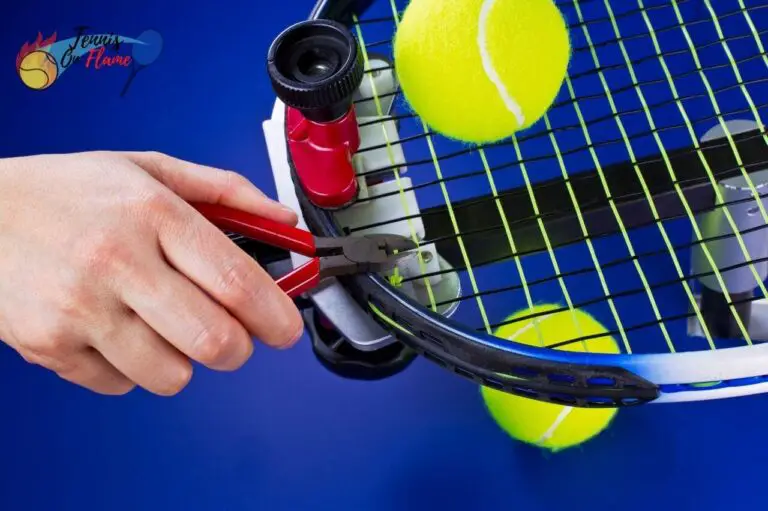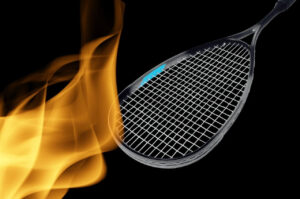A lot of tennis players ask themselves what the best tension for a tennis racket is.
The answer to this question depends on your playing style, as well as your personal preferences.
In this blog post, we will give you some tips on how to find the right tension for your racket, based on your playing style.
We will also discuss the benefits of finding the right tension for your racket, and how it can help you play better tennis!
What string tension should I use in my tennis racket?
String tension is basically how tight or lose the strings are pulled in the frame of the tennis racket, is just as essential as what string you choose for your tennis racket.
In general, beginners should use nylon strings, intermediate players can use hybrids, and expert players can compete on a complete bed of polyester.
The usual recommendation for tension is to string elastic materials like nylon or natural gut at 50-60 pounds, which we’ll use as a starting point.
The recommendation for Hybrid is around 46 to 56 pounds and 44 to 54 pounds in case you have polyester strings.
We’d recommend stringing looser if you’re using a more robust string material like polyester to avoid arm problems.

String tension by purpose and level
Before you are thinking about tension, you should ask yourself what is more important for you: more power or control?
Usually, beginners prefer to add more power because they are new and want to improve their shots-
While the advanced players prefer more control over their shots.
The more tension you have in your string, the better you’ll be able to control it. The looser your string tension, the more power it will have.
Nylon/Gut strings
If you want to power with nylon or gut strings, 50 to 55 pounds will fit well, while 56 to 60 pounds will be great for more control.
Hybrid strings
Use 46 to 51 pounds for more power and 52 to 56 pounds for more control.
Polyester strings
If you want power, 44 to 49 pounds will be good and 50-55 pounds will be great for more control.
What is the best tension for a tennis racket?
There is no definitive answer to this question.
The best tension for a tennis racket depends on your playing style, level, and purpose, as well as your personal preferences.
That being said, here are some tips on how to find the right tension for your racket:
If you are an aggressive player who likes to hit the ball hard, you will need a racket with more tension.
This will help you generate more power and speed when hitting the ball.
If you are a defensive player who likes to keep the ball in play, you will need a racket with less tension.
This will give you more control over the ball and make it easier to hit shots that stay in bounds.
In addition, it is important to consider your personal preferences when choosing the right tension for your racket.
Some players prefer a racket with more tension, while others prefer a racket with less tension.
The best way to find out what works best for you is to experiment with different tensions and see which one feels the most comfortable and gives you the best results.
What is considered good tension for a tennis racket?
Anyway, stringing elastic materials like nylon or natural gut around 50-60 lbs. is recommended by most manufacturers.
If you’re using a more durable string like polyester, reduce the tension to prevent arm injuries.
What string tension do pros use?
There is no one answer to this question, as professional players use a variety of different tensions depending on their playing style and the type of racket they are using.
However, many pro players use lower string tensions than amateur players, typically between 40 to 65 pounds.
This is because expert stringers usually recommend players to string their rackets as low as possible while yet being able to control the ball.
What tension does Rafael use?
Nadal’s strings are strung at a tension of 55 pounds.
This is quite low for a player who hits the ball so hard, but it gives him more touch and feels for his shots.
What tension does Federer use?
Federer uses a string that has been custom-designed for him. The mains are strung at a tension of 27kgs, while the crosses are strung at a tension of 25.5kg.
This gives him more power and control when hitting the ball.
His tension is considered low tension because he doesn’t care about the durability of his racket- He wanted a different feel on the string bed, and it’s because he’s using a tiny head.
What are the benefits of finding the right tension for your racket?
Finding the right tension for your tennis racket can have several benefits, including:
improved power and speed when hitting the ball;
increased control over the ball;
and reduced vibration and shock on impact.
All of these benefits can help you play better tennis and improve your game.
How do I choose the right string tension?
There is no one-size-fits-all answer to this question.
The first thing you should do is to know all the different strings that are out there:
The most popular strings are synthetic Gut, multifilament, polyester, and natural gut.
The second thing you should do is to take your time and experiment with different tensions using the different types of strings until you find one that gives you the best results.
What tension is good for the natural gut?
Strings made from natural gut should be tensioned in the range of 40 to 55 pounds.
This will help them hold their shape and deliver more power to your shots.
How much tension do tennis strings lose?
It’s very depending on the string’s type but usually, tennis strings can lose up to 20% of their tension within the first few days of use – even from the second they left the stringing machine.
This is because they stretch and loosen as you play, so it is important to retain your strings regularly to keep them at their best.
So over time, all tennis strings will lose tension.
What about people with arm problems?
If you have arm problems, it is best to reduce the tension on your racket strings.
This will reduce the vibration and shock on impact, which can help to prevent further injury or pain.
What are the typical tension ranges?
Generally, a good range to start with is between 45-60 lbs.
If you are an aggressive player who likes to hit the ball hard, then you will need more tension (above 60 lbs).
If you like keeping the ball in play and want better control over it, then less tension (below 50) might be a better option for you.
As stated before, it is important to experiment with different tensions and find the one that feels best for you. There is no one-size-fits-all answer!
Another thing that you need to remember is that every tennis racket has its typical tension range-
so if you buy a new racket, then it is recommended to use the tension range that was made for that specific model.
How to check the string tension?
There are a few different ways to check the string tension on your tennis racket.
The first is a tool you may use before actually stringing that requires you to have a stringing machine.
The second instrument is a tension testing tool, which is used by technicians and players to check string tension after a racquet has been restrung.
You can purchase analog, electric, and even acoustically based apps.
Another way is to use a tension meter, which is a small device that measures the amount of force needed to stretch the strings.
Does higher tension mean more spin?
Not necessarily because the ball will fall shorter on a racquet with tighter strings. To compensate, the player may swing harder, resulting in more spin.
This is when the tension of the strings has no bearing on spin production. Rather, it’s the player’s response to tighter strings that does the trick.
How often should I restring my tennis racket?
This depends on how often you play, the type of strings you use, and the tension you keep them at.
Most players retain their strings every two to three weeks; however, if you’re a more aggressive player who likes to hit the ball hard, then you might need to restring your racquet more often- even every 10 to 15 hours!
The best rule of thumb is to listen for the “ping” sound during play.
If you hear that, then it’s time to restring your racquet because this means that there are too many dead strings on top causing less power when hitting shots.
In conclusion
There is no one-size-fits-all answer when it comes to string tension or how often you should restring your racquet.
The best thing to do is experiment with different tensions and find the one that feels best for you!
When in doubt, always consult a professional stringer: they are the experts on these topics.
Make sure to keep an eye on your strings and retention them regularly to get the most out of your tennis game.
Do you have any recommendations for string tension? leave them in the comments below!








